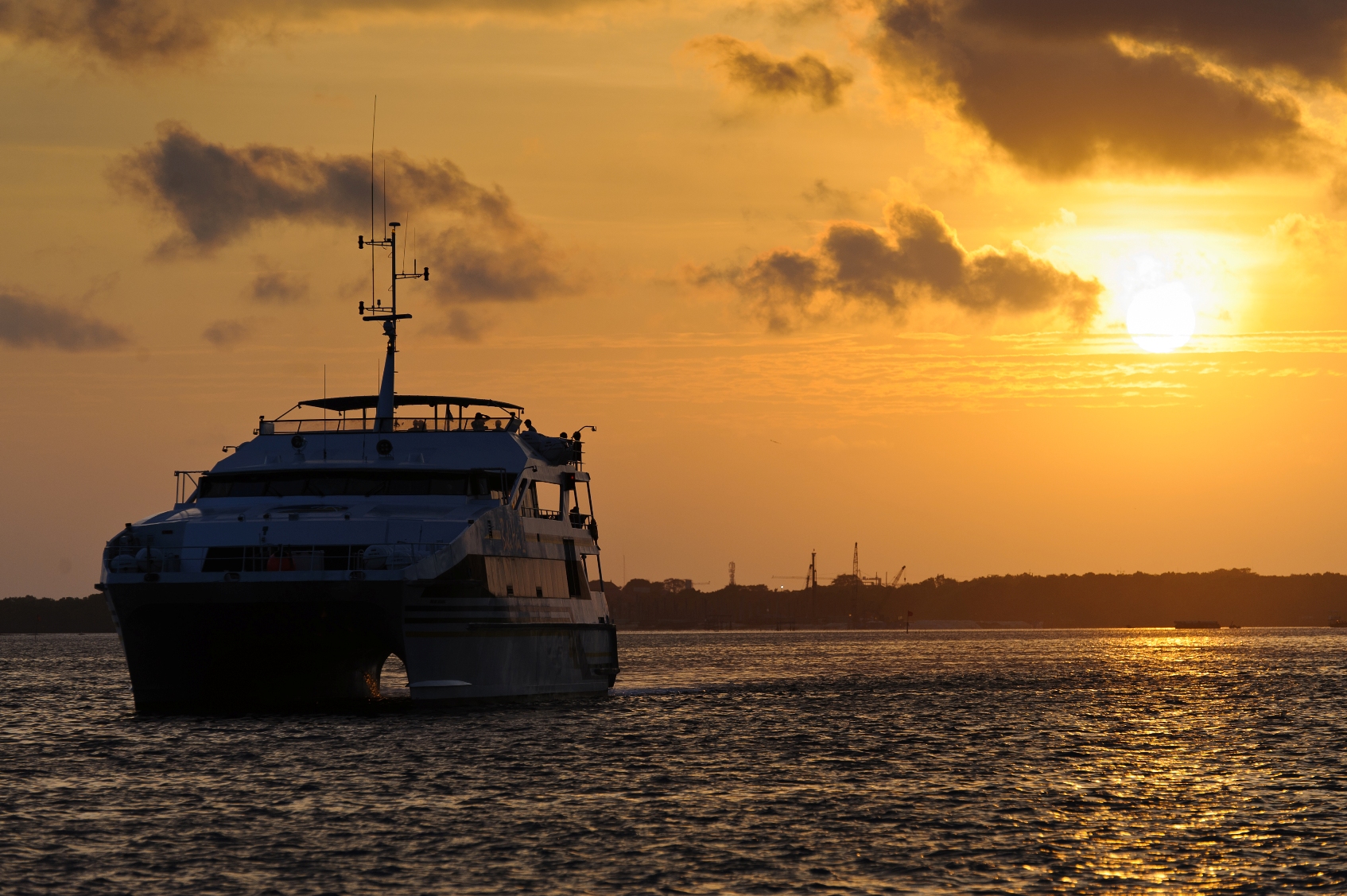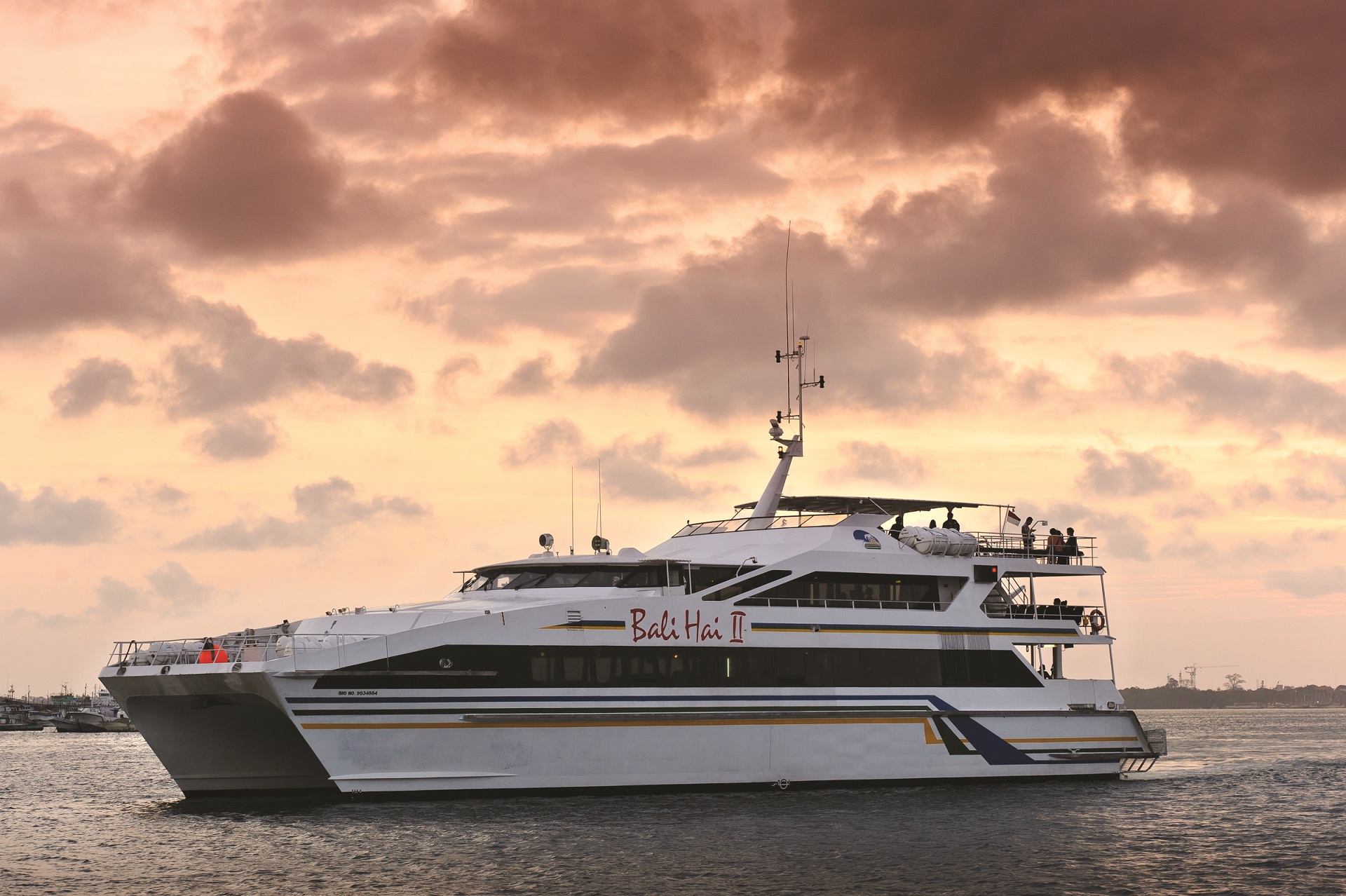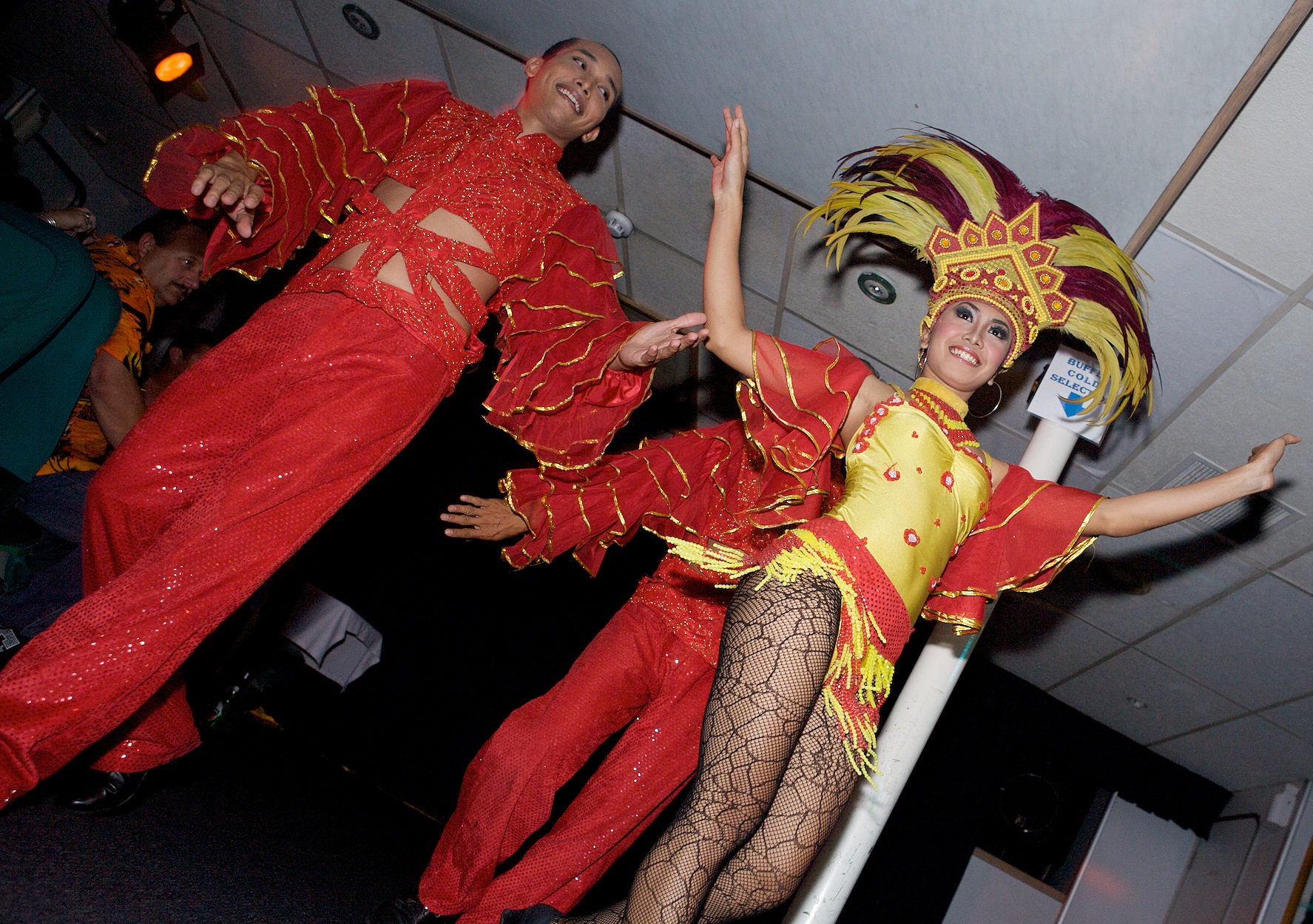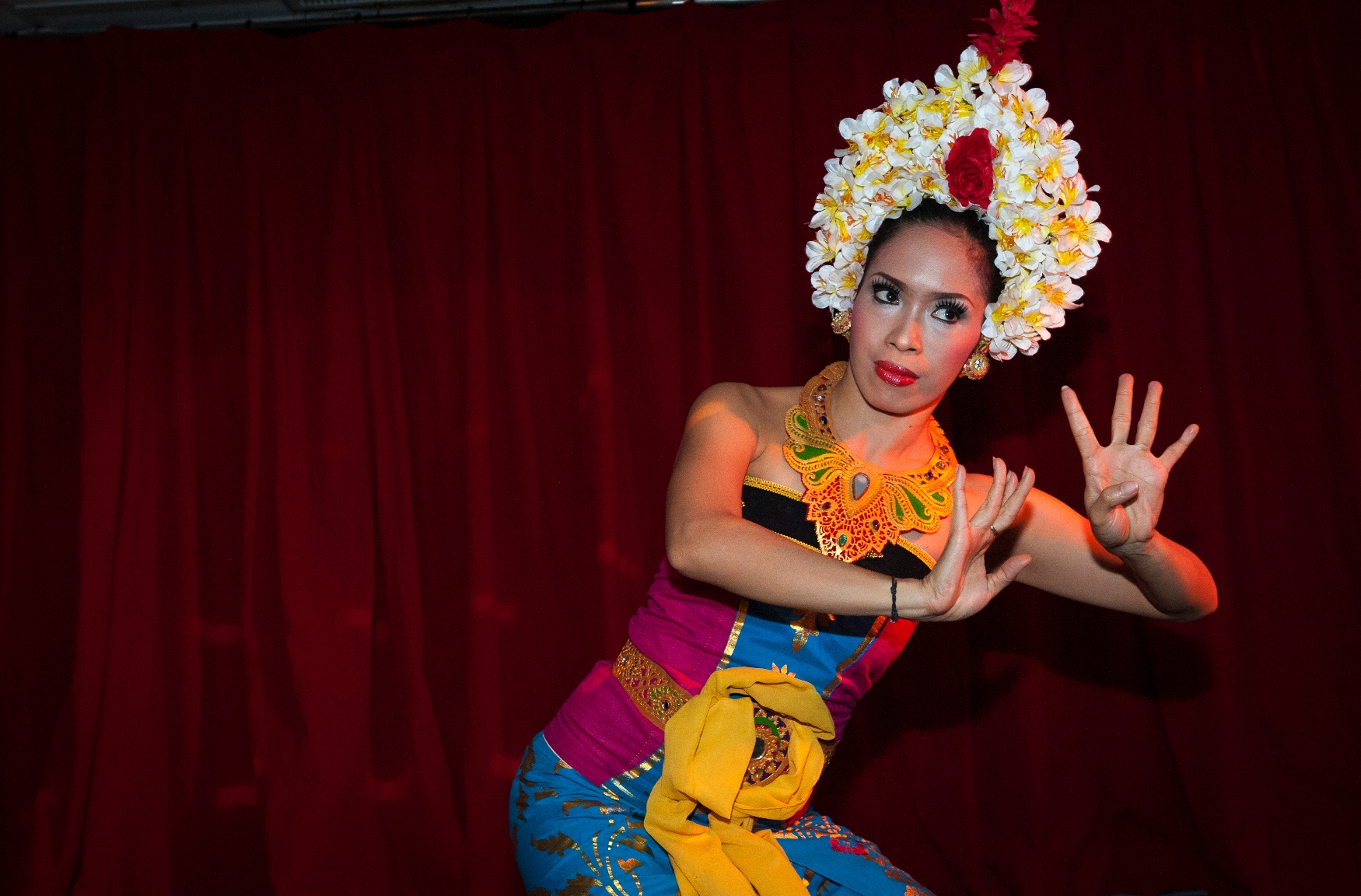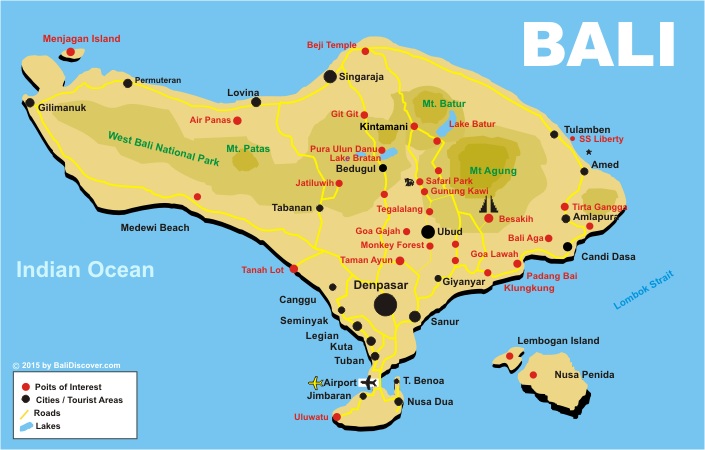General
Bali Sunset Dinner Cruise
Spend an evening in Bail out on the water during this sunset dinner cruise. Enjoy the cooler twilight air, admire views of the Benoa coast and harbor, and feast on a buffet of both Indonesian and international cuisine. You’ll be entertained throughout the cruise by traditional songs, a cabaret show and a DJ.
Tour Code: GS 40 A
Starts: every day
Pick up: 4.00 pm (at your hotel), Return at 21:00 pm
Duration: about 5 hours
Price: US$ 55 / person (minimum 2 persons)
Hotel pickup and drop-off is included.
Tour description:
There’s no better way to spend a balmy tropical evening than on Bali Hai’s evening Dinner Cruise.
After pickup from major hotels in southern Bali, head to the marina in Benoa for your 3-hour dinner cruise. Then board the boat and enjoying a welcome cocktail and selection of capanes while you wait for the cruise to depart. Watch the sunset and admire views of the Bali coastline from the deck of the boat, and then head to the buffet for dinner, which consists of a variety of Indonesian and international dishes. While your dinner you be entertained by famous strolling Batakos Singers, savour a delicious international buffet dinner, then dance the night away at disco or enjoy live cabaret show. The onboard entertainment continues with a cabaret show followed by a DJ to end the night with some lively tunes.
When you return to the marina, your tour ends with hotel drop-off.
This tour is inclusive hotel transfer and delicious buffet dinner.
Tour include:
- Hotel transfer (pick up & drop off)
- Boat cruise in a modern Bali Hai catamaran
- Delicious buffet dinner on board
- Entertainment and show program
- Insurance
- English speaking guide at transportation
- English speaking stafff on board
Remarks:
- Prices are net per person and inclusive tax and service charge.
- Other personal expenses are not included and will be on personal account.
- Single Surcharge: US $ 25.
- Don’t forget to bring: Sun cream, photo camera, extra monex for drinks, tips and souveniers.
- We will pick you up at your hotel in Bali and after the cruise we will bring you back to your hotel.
Price: US$ 55 / person (minimum 2 persons)
Available departures
Thank you for choosing BaliDiscover.com
Most our tours are a private tours, so you can join any day.
The promotion rates are applicable all year through.
Reservations should be made mimum 2 days in advance as we have to arrange everything for your tour.
All rates are inclusive 21% government tax and service charge.
Please provide us also following details in the "special requirements" field for your pick up: Your hotel in Bali, name, address or cruise ship port.
All internet bookings will be confirmed by email.
Please check also our terms and condition.
If you have questions please use our
general inquiry form
We promise to make your holiday in Bali unforgettable by providing you a wonderful Bali sightseeing or activity tour.
Bali

Bali, Indonesia
Bali, the famed “Island of the Gods”, with its varied landscape of hills and mountains, rugged coastlines and sandy beaches, lush rice terraces and barren volcanic hillsides all providing a picturesque backdrop to its colourful, deeply spiritual and unique culture, stakes a serious claim to be paradise on earth. With world-class surfing and diving, a large number of cultural, historical and archaeological attractions, and an enormous range of accommodations, this is one of the world’s most popular island destinations and one which consistently wins travel awards. Bali has something to offer a very broad market of visitors from young back-packers right through to the super-rich.
Travel & Leisure Magazine has awarded Bali the World’s Best Island in 2009, while the Lonely Planet’s Best of Travel 2010 ranked Bali second place among the world’s Top Regions.
The rapid growth of development in tourism has had a big impact and influences to Bali tradition and lifestyle. Interestingly, Balinese culture is still as what it was, growing along with the of globalization. It is the Balinese civilization what makes the island different from other destination.
The tourism industry is primarily focused in the south, while significant in the other parts of the island as well. The main tourist locations are the town of Kuta (with its beach), and its outer suburbs of Legian and Seminyak (which were once independent townships), the east coast town of Sanur (once the only tourist hub), in the center of the island Ubud, to the south of the Ngurah Rai International Airport, Jimbaran, and the newer development of Nusa Dua and Pecatu.
Bali Geography
The island of Bali lies 3.2 km (2 mi) east of Java, and is approximately 8 degrees south of the equator. Bali and Java are separated by the Bali Strait. East to west, the island is approximately 153 km (95 mi) wide and spans approximately 112 km (69 mi) north to south; administratively it covers 5,780 km2, or 5,577 km2 without Nusa Penida District,[24] its population density is roughly 750 people/km2.
Bali’s central mountains include several peaks over 3,000 metres in elevation. The highest is Mount Agung (3,031 m), known as the “mother mountain” which is an active volcano. Mountains range from centre to the eastern side, with Mount Agung the easternmost peak. Bali’s volcanic nature has contributed to its exceptional fertility and its tall mountain ranges provide the high rainfall that supports the highly productive agriculture sector. South of the mountains is a broad, steadily descending area where most of Bali’s large rice crop is grown. The northern side of the mountains slopes more steeply to the sea and is the main coffee producing area of the island, along with rice, vegetables and cattle. The longest river, Ayung River, flows approximately 75 km.
Bali Climate
Being just 8 degrees south of the equator, Bali has a fairly even climate year round. With sunshine shining throughout the year, Bali has a tropical monsoon climate, with pleasant day temperatures between 20 to 33 degrees Celsius or 68 to 93 degrees Fahrenheit. Rainy season starts from October to March, when the West monsoon brings heavy showers and high humidity. June to September is considered the driest season, with low humidity and it can be fairly cold in the evenings, the best time for any outdoor activities.
Religion
Unlike most of Muslim-majority Indonesia, about 83.5% of Bali’s population adheres to Balinese Hinduism, formed as a combination of existing local beliefs and Hindu influences from mainland Southeast Asia and South Asia. Minority religions include Islam (13.3%), Christianity (1.7%), and Buddhism (0.5%). These figures do not include immigrants from other parts of Indonesia.
Balinese Hinduism is an amalgam in which gods and demigods are worshipped together with Buddhist heroes, the spirits of ancestors, indigenous agricultural deities and sacred places. Religion as it is practised in Bali is a composite belief system that embraces not only theology, philosophy, and mythology, but ancestor worship, animism and magic. It pervades nearly every aspect of traditional life. Caste is observed, though less strictly than in India. With an estimated 20,000 puras (temples) and shrines, Bali is known as the “Island of a Thousand Puras”, or “Island of the Gods”. This is refer to Mahabarata story that behind Bali became island of god or “pulau dewata” in Indonesian language.
Bali Culture
Life in Bali is very communal under the organization of villages. Temple ceremonies, marriage, cremation, farming and even the creative art festivals are decided by the local community institution called “Banjar”. The responsibilities in the day-to-day life are normally administered by both the Banjar and the government. The local government mostly responsible for schools, health clinics, hospitals and roads, and Banjar is responsible for all other aspects of life. There is another association exists in the banjar named “Subak” that concerns to the production of rice and organizes the complex irrigation system. Every family who owns a rice field must be a member of their local Subak, which then ensures that every member gets his fair distribution of water. A banjar consists of an average of 50 to 150 family members, owning a meeting venue called the Bale Banjar, which is used for regular gatherings and a center for local gamelan orchestras and drama groups.
Bali is renowned for its diverse and sophisticated art forms, such as painting, sculpture, woodcarving, handcrafts, and performing arts. Balinese cuisine is also distinctive. Balinese percussion orchestra music, known as gamelan, is highly developed and varied. Balinese performing arts often portray stories from Hindu epics such as the Ramayana but with heavy Balinese influence. Famous Balinese dances include pendet, legong, baris, topeng, barong, gong keybar, and kecak (the monkey dance). Bali boasts one of the most diverse and innovative performing arts cultures in the world, with paid performances at thousands of temple festivals, private ceremonies, or public shows.
The Hindu New Year, Nyepi, is celebrated in the spring by a day of silence. On this day everyone stays at home and tourists are encouraged to remain in their hotels. On the day before New Year, large and colourful sculptures of ogoh-ogoh monsters are paraded and finally burned in the evening to drive away evil spirits. Other festivals throughout the year are specified by the Balinese pawukon calendrical system.
Temples
Bali is known as an island of thousands temples. In every village in Bali, there are several temples and at least one small temple in each home of Balinese which reach to a total of 10.000.
Balinese word for temple is ‘pura’ which means ‘space surrounded by a wall‘. Although many temples are quiet and uninhabited, they are transformed into colorful, active and decorated places of worship when there is a festival. While offerings are made, performances of traditional dances and gamelan, cockfighting and gambling enliven the atmosphere.
All temples derive their direction from the mountains and the sea. The direction toward the mountains, Kaja, is the most significant direction. The direction toward the sea is Kelod. The direction toward the sunrise, Kangin, is found in most secondary shrines.
Bali History
The first Hindus arrived in Bali as early as 100 BC, but the unique culture which is so apparent to any current day visitor to Bali hails largely from neighbouring Java, with some influence from Bali’s distant animist past. The Javanese Majapahit Empire’s rule over Bali became complete in the 14th century when Gajah Mada, Prime Minister of the Javanese king, defeated the Balinese king at Bedulu.
The rule of the Majapahit Empire resulted in the initial influx of Javanese culture, most of all in architecture, dance, painting, sculpture and the wayang puppet theatre. All of this is still very apparent today. The very few Balinese who did not adopt this Javanese Hindu culture are known today as the Bali Aga (“original Balinese”) and still live in the isolated villages of Tenganan near Candidasa and Trunyan on the remote eastern shore of Lake Batur at Kintamani.
With the rise of Islam in the Indonesian archipelago, the Majapahit Empire in Java fell and Bali became independent near the turn of the 16th century. The Javanese aristocracy found refuge in Bali, bringing an even stronger influx of Hindu arts, literature and religion.
Divided among a number of ruling rajas, occasionally battling off invaders from now Islamic Java to the west and making forays to conquer Lombok to the east, the north of the island was finally captured by the Dutch colonialists in a series of brutal wars from 1846 to 1849. Southern Bali was not conquered until 1906, and eastern Bali did not surrender until 1908. In both 1906 and 1908, many Balinese chose death over disgrace and fought en-masse until the bitter end, often walking straight into Dutch cannons and gunfire. This manner of suicidal fighting to the death is known as puputan. Victory was bittersweet, as the images of the puputan highly tarnished the Dutch in the international community. Perhaps to make up for this, the Dutch did not make the Balinese enter into a forced cultivation system, as had happened in Java, and instead tried to promote Balinese culture through their policy of Baliseering or the “Balinisation of Bali”.
Bali became part of the newly independent Republic of Indonesia in 1945. In 1965, after the failed coup d’etat which was allegedly backed by the Communist Party (PKI), state-instigated, anti-communist violence spread across Indonesia. In Bali, it has been said that the rivers ran red with the reprisal killings of suspected communists—most estimates of the death toll say 80,000, or about five percent of the population of Bali at the time.
The current chapter in Bali’s history began in the seventies when intrepid hippies and surfers discovered Bali’s beaches and waves, and tourism soon became the biggest income earner. Despite the shocks of the terrorist attacks in 2002 and 2005, the magical island continues to draw crowds, and Bali’s culture remains as spectacular as ever.
Bali Travel Facts:
Please see our Bali Infos here
Accommodations:
Please find our Bali Hotel List here.
Why not stay in a private luxury Bali Villa ?
Find here our Bali Villa List
Tours and Sightseeing in Bali:
Find here our private Tours for Bali
Read more
Indonesia

Indonesia straddles the Equator between the Indian Ocean and the Pacific Ocean. While it has land borders with Malaysia to the north as well as East Timor and Papua New Guinea to the east, it also neighbors Australia to the south, and Palau, the Philippines, Vietnam, Singapore, and Thailand to the north, India to the northwest.
With 18,110 islands, 6,000 of them inhabited, Indonesia is the largest archipelago in the world. About 240 million people live in this fourth most populous country in the world — after China, India and the USA — and by far the largest country in Southeast Asia. Indonesia also has the largest Muslim population in the world. Indonesia’s population is on course to overtake the US and become the third largest before 2044. In the decade that ended in 2010, population growth remained high at 1.49% each year but there is substantial Muslim opposition to boosting family planning.
Indonesia is the fourth largest country in the world is home to more than 195 million people. Mainly Muslims — with substantial Christian, Hindu and Buddhist minorities. Indigenous tribes still exist in Borneo to Irian Jaya in Eastern Indonesia. The presence of their pagan ancestry can still be seen, heard and felt by those who dare to breach the tourist frontiers.
The largest Indonesian islands are Sumatra, Java, Kalimantan (Indonesian Borneo), Sulawesi, and the Indonesian part of New Guinea (known as Papua or Irian Jaya).
Indonesia markets itself as Wonderful Indonesia, and the slogan is quite true, although not necessarily always in good ways. Indonesia’s tropical forests are the second-largest in the world after Brazil, and are being logged and cut down at the same alarming speed. While the rich shop and party in Jakarta and Bali. After decades of economic mismanagement 50.6% of the population still earns less than USD2/day according to figures compiled by the World bank in 2009. This had come down by 6% in the 2 years between 2007 and 2009.
Infrastructure in much of the country remains rudimentary, and travellers off the beaten track will need some patience and flexibility.
According to the “Energy Access” Working Group Global Network on Energy for Sustainable Development, in 2001, 53.4% of the Indonesian population had access to electricity and they consumed 345kWh for each person in a year. In the same year the residents of nearby Singapore had 100% access and they consumed 6,641 kWh. A very large percentage of the Indonesian population remain reliant upon wood for a cooking fuel. The central government has in recent years instituted a program of LPG gas access to use as a replacement for the burning of bio-mass sources for cooking.
A wonderfully fullfilling destination, Indonesia is a land of contrasts, a land where the spiritual manifests itself through magnificent temples and artwork. Mother Nature is not to be outdone with dramatic landscapes, active volcanoes and picture-perfect postcards. Indonesia’s fauna is exotic to say the very least, with huge lizards, orangutans and various tropical fish.
Nature:
Both below and above water, Indonesia’s biodiversity is unrivalled. Tigers, elephants, rhinos, orangutans, cloud leopards, tapirs and a multitude of rare, threatened and amazing wildlife are found in the nation’s forests and swamps. New species are constantly being discovered.
On the eastern part of the archipelago, separate from the Asian landmass, the islands of Sulawesi, Nusa Tenggara and Maluku have seen the evolution of species that are markedly different from western Indonesia.
Further to the east, Papua (originally part of the Australian landmass) exhibits a range of unique habitats, including more than 700 bird species (including migrants).
Indonesia’s warm seas are home to marine turtles, whales, dugongs and the world’s largest diversity of tropical marine species.
Culture:
Indonesia has about 300 ethnic groups, each with cultural identities developed over centuries, and influenced by Indian, Arabic, Chinese, and European sources. Traditional Javanese and Balinese dances, for example, contain aspects of Hindu culture and mythology, as do wayang kulit (shadow puppet) performances. Textiles such as batik, ikat, ulos and songket are created across Indonesia in styles that vary by region. The Indonesian film industry’s popularity peaked in the 1980s and dominated cinemas in Indonesia, although it declined significantly in the early 1990s. Between 2000 and 2005, the number of Indonesian films released each year has steadily increased.
History:
Indonesia has a rich and fascinating history. The majority of Indonesia’s modern population is made up of Austronesian people, who originally migrated to South East Asia from Taiwan. They arrived in Indonesia around 2,000 BC and quickly spread throughout the archipelago, pushing the indigenous Melanesian people to the far eastern regions.
Trade contracts eventually brought outside cultural and religious influences to Indonesia from India, China, and mainland Southeast Asia. Starting from the 7th century, the powerful Srivijaya kingdom flourished as a result of the Hindu and Buddhist influences that were imported into Indonesia along with traded goods. Srivijaya was one of the first Indian-ized empires and grew up around the coast of Sumatra, serving as the hub of a trading network that reached to many parts of the archipelago.
Indonesia Travel Facts:
Visas
Two months’ entry visa free for tourists from major markets. All visitors must have passports valid for at least six months and proof of onward passage.
Airport Taxes
Airport tax levied on passengers for international travel is Rp.21,000. for travel within Indonesia regional variations occur. Expect to pay an average of about Rp.8,000.
Health
International health certificates for smallpox and cholera are not required, except from travelers arriving from infected areas. Bottled water is provided everywhere, even in the smallest villages. It is never advisable to drink tap water anywhere in Indonesia. Be sure to travel with Immodium AD since it is not easy to find there and you don’t want to discover that when its too late.
Customs
Indonesian customs allows on entry a maximum of two liters of alcoholic beverages, 200 cigarettes or 50 cigars or 100 grams of tobacco and a reasonable amount of perfume per adult. Cars, photographic equipment, typewriters and tape recorders must be declared to Customs upon entry and must be re-exported. Prohibited from entry are TV sets, radios, narcotics, arms and ammunition, printed matter in Chinese characters and Chinese medicines. Advance approval has to be acquired for carrying transceivers and all movie films and video cassettes must be censored by the Film Censor Board. Fresh fruit, plants and animals must have quarantine permits. There is no restriction on import or export of foreign currencies. However, the export or import of Indonesian currency exceeding Rp.50,000 is prohibited.
Currency & Money Exchange
The Rupiah is the currency used in Indonesia in notes 100, 500, 1,000, 5,000, 10,000, 20,000, 50,000. The most commonly used note is 50,000 Rupiah (about $5 US). There are many places available to exchange your dollars. You’ll get a better exchange rate for crisp, clean US $100 bills. Old or dirty bills may not be accepted. As with any foreign country, it is advisable to understand the exchange rate before you go to exchange your money so you should have a good idea of how many Rupiah to expect for your US dollars.
Credit Cards
Major credit cards are acceptable in most hotels along with American dollar travelers’ checks.
Banking
Normal banking hours are from 8:00 am to 2:30 pm from Monday to Friday. Some bank branches in hotels, however, keep longer hours. Jakarta has several international banks but money can also be changed at hotel cashiers, and authorized money changers. Daily exchange rates are published in newspapers. The US dollar is the most readily accepted currency. Most major tourist destination areas have foreign exchange facilities, but for travel to remote areas it is advisable to change money and travelers cheques in advance.
Tipping
Major hotels usually add a 10% service charge to bills. Where it is not included a tip of between 5% to 10% of the bill would be appropriate if the service is satisfactory. Airport porters expect Rp.2,000 for a small bag and Rp.3,000 for bags weighing more than 20 kg. Tipping taxi and hire-car drivers is not mandatory, but if service has been satisfactory a basic Rp.1,000 tip is sufficient for a taxi driver, Hire-car drivers would normally expect a larger tip.
Security
Keep your valuables in the hotel safe deposit box or a similar safe place and your passport close to your body.
Language:
The official language of Indonesia is ‘Bahasa Indonesia.’ There are also several hundred local languages, such as Javanese or Papuan languages. Most Indonesians speak their ethnic language as their mother tongue as well as the official language of Bahasa Indonesia.
Etiquette
Being aware of local customs and taboos is very important when traveling in any foreign land. In Indonesia you will always be ensured of having a pleasant time if you act with decorum and dress appropriately. On greeting someone it is customary for both men and women to shake hands. This should only be done with the right hand because to shake hands, give or receive, or eat with the left hand is considered impolite. Pointing or summoning someone with your index finger is considered impolite and care should be taken not to climb over places of worship or local monuments.
Clothing
Light, airy, casual clothes are the most practical and you’ll find natural fibers like cotton or linen are the most comfortable in Indonesia’s often humid conditions. Indonesians are very clothes conscious and it’s particularly important to be properly dressed when visiting government offices such as the immigration offices. Indifference to local customs, scanty clothing is not advisable in public places, shorts are not permitted in mosques and women should have their head and arms covered. In Bali, waist sashes should be worn when visiting temples.
Electricity
Power supply is 220 volts/250 cycles in large cities, but 110 volts is still used in some areas. Normal outlets are plugs with two rounded pins (see photo). It is advisable to check electricity supplies before using any appliances.
Telephone Internet Services
You’ll find internet cafes in most the major cities. On Bali they are everywhere and you can comfortably get online for anywhere from less than 10,000 Rp to 30,000 Rp ($1-3 US). The connections can be slow so don’t expect to do too much web surfing in that hour, but its great for anyone who wants to keep up on email and/or stay in touch with friends and family back home.
Read more
Facilities
- Air Condition
- Bar
- Lounge
- Restaurant
Boat Facilities
We are sorry, there are no reviews yet for this cruise.
Thank you for choosing BaliDiscover.com
Please note:
Most our tours are a private tours, so you can join any day.
The promotion rates are applicable all year through.
All rates are inclusive government tax and service charge.
Reservations should be made mimum 2 days in advance as we have to arrange everything for your tour.
Please provide us also following details in the "special requirements" field for your pick up: Your hotel in Bali, your address in Bali or cruise ship port.
All internet bookings will be confirmed by email.
Please check also our terms and condition.
If you have questions please use our
general inquiry form
We promise to make your holiday in Bali unforgettable by providing you a wonderful Bali sightseeing or activity tour.

